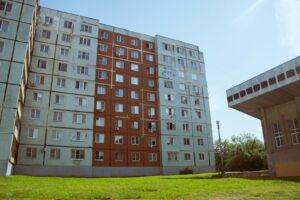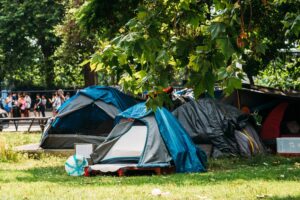The blaze first broke out at 2.51PM (Hong Kong time) in the Wang Fuk Court residential complex in the city’s northern Tai Po district.
High-rise buildings wrapped in bamboo scaffolding caught fire, killing four people so far. Police and local media outlets have reported that multiple residents remain trapped inside, while two others are in critical condition with severe burns. Some firefighters were also injured while attempting to extinguish the flames.
Eyewitnesses and emergency-services footage showed flames engulfing sections of bamboo scaffolding and construction netting draped around the exterior of the towers – a factor widely cited as accelerating the fire’s spread across the complex.
The incident was escalated to a No. 4 alarm, the second-highest severity level, by 3.34 PM. The complex comprises eight blocks with around 2,000 residential units, making evacuation and rescue efforts particularly challenging.
The fire has highlighted the risks of using bamboo scaffolding. Valued for its low cost and availability, the material is used in dozens of countries, some include China, India, Sri Lanka and parts of Africa and South America.
Our Editor-in-Chief, Paul Day, who is currently on holiday in Hong Kong, commented on the blaze: ‘I’ve spent a week marvelling at the skill and ingenuity involved in erecting bamboo scaffolding many floors into the air.
‘I thought it could be the future of environmentally conscious construction but it turns out to be very much a dangerous relic of the past.’
Earlier this year, Hong Kong authorities announced plans to gradually phase out bamboo scaffolding in public-sector projects, replacing it with metal. The Development Bureau cited safety concerns, including bamboo’s combustibility and its tendency to deteriorate over time.
Data from the Hong Kong’s Labour Department underscores the risks: between 2018 and 2024, 23 people were killed in bamboo-scaffolding related accidents. including four fatalities from three separate cases in 2024 alone.
Rescue operations are still ongoing for the fire and the tragedy has renewed calls for stricter safety measures and the wider adoption of more fire-resistant scaffolding materials.
This devastation bares similarities to the Grenfell disaster which took place in June 2017. The London fire took the lives of 72 people and led to significant changes in UK building regulations, including a cladding ban that was announced in December 2018.
UPDATE: Since the fire broke out on Wednesday, the death toll has climbed to at least 128 people with hundreds injured. In addition, over 300 people are reported as missing.
Although the cause of the fire is yet to be determined, police alleged that unsafe scaffolding and foam materials used during maintenance work may have been behind the rapid spread of the blaze. Three men from a construction company – two directors and one engineering consultant – have been arrested.
Eileen Chung, a Hong Kong police superintendent, said: ‘We have reason to believe that the company’s responsible parties were grossly negligent, which led to this accident and caused the fire to spread uncontrollably, resulting in major casualties.’
Grenfell United, a campaign group comprised of survivors and bereaved families who experienced the Grenfell tragedy in London, have taken to X (formerly known as Twitter) to express their support for those in Hong Kong.
The post read: ‘Our hearts go out to all those affected by the horrific fire in Hong Kong.
We are thinking of every family waiting for news, mourning loved ones, or holding onto hope for those still missing.
To the families, friends and communities, we stand with you. You are not alone.’
Image: Peter Berko/UnSplash
In related news:
Health problems drive homelessness, campaigners call for action


















Leave a Reply